On September 18, Fujitsu held the Fujitsu World Tour 2019 conference in Moscow, once again bringing together within the walls of the Renaissance Moscow Monarch Center all who unevenly breathe to the world of high technology. And I must say, even we did not expect that so many people interested in IT would come to us - more than 700 people! Fortunately, they had no time to get bored, because this year we tried to fill the conference with expert presentations, demonstrations of new products and various activities. But let's take it in order.
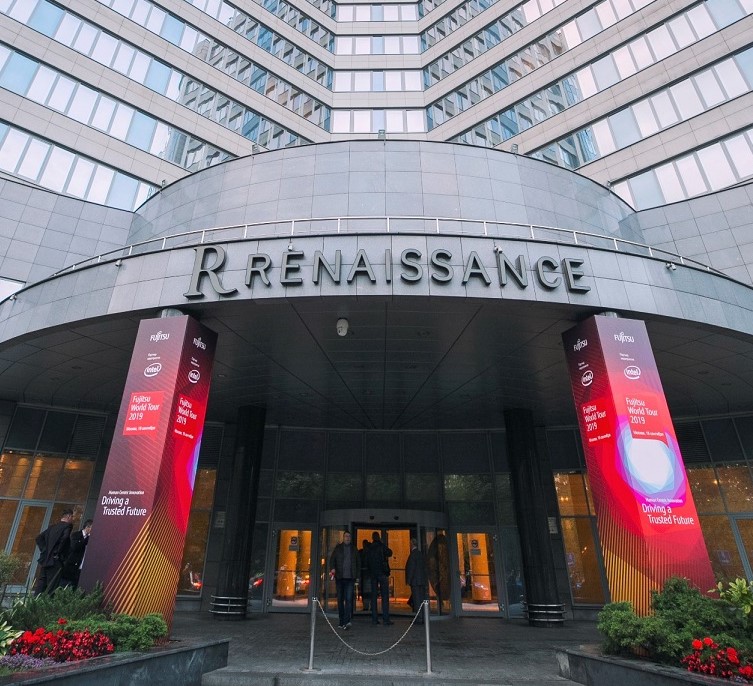
The day began early, at 9 in the morning we met the first "early bird". Although there was still an hour and a half before the official opening, Fujitsu products and technologies exhibition was already open for guests. In the demo zone of mobile technologies and client devices, you could look at all the details, turn your hands and test the latest transformer notebooks of the updated LIFEBOOK line (including the extremely lightweight U939X, which we wrote about earlier ), as well as evaluate the compactness of desktop PCs ESPRIMO (for example, the G558 model is the size of a small book, although the productive filling is hidden inside it). In the second demo zone, “heavy” server hardware was traditionally displayed.

It was also possible to brighten up the expectation of an official opening for interactive games (prizes could be obtained for good results) by visiting the photo zone and immediately printing a successful photo or finally waking up with a cup of strong coffee. Next, guests were waiting for a rich plenary part in two acts with an intermission. Here are some important reports from her.
“With confidence in data and technology”
This year, the main theme of the Fujitsu World Tour was trust. It was the speech of confidence that the conference was opened by the General Director of Fujitsu in Russia and the CIS Vitaly Fridlyand. The world is rapidly changing; in the future, like a locomotive, innovations are dragging us at full speed. And largely because of the super-fast changes that innovation is causing, we are keenly aware of the problem of trust in everything around us. Including technology. 100 years ago, to call someone, they said “operator, connect,” later you had to turn the dial, and now you can not even press the buttons, just command the smartphone, thanks to speech recognition, he will understand you and choose the number you need. And since technology has become so wiser, you are increasingly wondering if they will eventually replace people. For Vitaly, the answer to this question is definitely not. Man is indispensable, and new technologies are recognized only to expand his capabilities.

Vitaliy Fridlyand, Fujitsu CEO in Russia and the CIS
As an example, he cited an AI-based system developed by Fujitsu in conjunction with the International Gymnastics Federation. It does not replace (and is unlikely to replace at all) judges, but helps them in assessing the performance of gymnasts and reduces the likelihood of a judicial error in assessing the performance technique. 3D sensors continuously monitor each movement of the athlete, and artificial intelligence analyzes the data stream. As a result, a 3D model of the gymnast’s performance is created, which can be viewed from any angle. Evaluation of the artistic performance of the issue remains the sole responsibility of the jury.
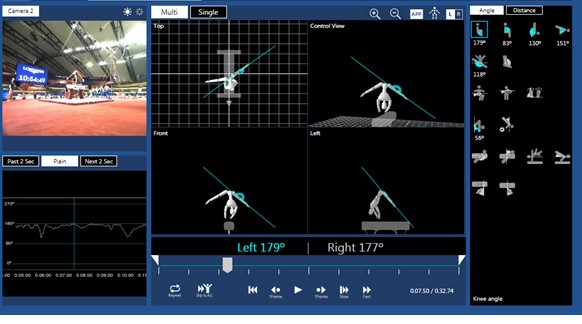
System interface
By the way, the system has already been officially introduced at the World Championships in gymnastics, which was held in early October in Stuttgart. By 2022, it will be used in all championships of the federation along with a video replay system (Instant Replay and Control System, IRCOS).
Continuing his talk about trust, Vitaly turned to the problem of AI black box for illustration. Indeed, they are afraid of artificial intelligence more because people don’t understand how it works, what happens inside the black box. To resolve these fears is quite simple (at least in theory), you just need to create such an AI that can explain how he made this or that decision. Fujitsu Explainable AI was created precisely for this purpose. When the technology, like a schoolboy at the blackboard, paints the whole process of the decision and its logic becomes clear, you somehow relax inwardly and thoughts about the future of mankind from the classics with 1984 Arnold Schwarzenegger disappear. Any trust is built on openness, transparency and honesty, including in relation to technology.
From Information Technology to Intelligent
Following Vitaly Friedland, Dr. Joseph Reger, CTO of Fujitsu in Europe, entered the scene. He began with a greeting in Russian and already in English regretted that although he had studied Russian when growing up in Hungary, the phrase from the
And there was something to talk about. For his speech, Dr. Reger recalled Bernard Shaw, dialectical materialism, Gordon Moore, the course of theoretical physics Landau-Lifshitz, and also seriously talked about artificial intelligence and quantum computing - two of the most important, in his opinion, technologies, the combination of which will take us to a new level of development . In details, this bright monologue can be seen in the video below, but here are a couple of main thoughts from it.
We are now at a stage when IT capabilities, their power and speed have grown, according to Dr. Reger, trillions of times compared to what was at the beginning of the journey. And this leap in power allows us to do those things that were previously inaccessible to us.
For example, create a working AI. About 60 years ago, scientists believed that to create artificial intelligence, they needed computers and two months of work of a team of 10 people, but only recently mankind managed to get to “narrow AI” (or “weak AI”), which can only perform highly specialized tasks . And at the current stage, AI is still far from ideal, weakly similar to us. For example, a child does not need to show 10 million cats, so that he eventually learns to distinguish them from other animals.
And not all high-profile victories of artificial intelligence over man were the first to participate at all. The very famous Deep Blue, who defeated the 13th world chess champion Garry Kasparov, was just a huge library of almost all variants of the development of the chess game, coupled with the fastest iron of the time.

Joseph Reger, CTO Fujitsu Europe
So, narrow AI is hardly able to exist and work effectively without a human being. According to Joseph’s forecasts, in about 50 years we’ll finally reach a “strong AI” that will be able to learn like us. And after some time we should expect artificial superintelligence, where some AI systems will be able to create other AI systems. And only at this stage it is worth starting to worry a little about whether artificial intelligence will squeeze us.
Fortunately (or unfortunately) we will not get to it soon. In the field of machine learning, there are two important tasks that must be solved before moving on. The first is the already mentioned AI black box problem. The second problem is that the hardware that we use now for AI is not powerful enough for the future development of this technology, because it needs more resources for training. To create general AI, and especially super AI, we need another huge leap in power. Joseph believes that iron will again have to become more powerful at least a trillion times.
Moore's law will not work forever, since it is impossible to increase the number of transistors in one circuit to infinity, according to this logic, someday they should become the size of an electron, and then smaller than it, which from Reger's point of view, a physicist by education, is impossible. Therefore, we will have to find some other way out to increase the hardware power.
The solution can be quantum computing, where, unlike bits, which can only be in two states (for example, 0 or 1), qubits in a superposition state can simultaneously have both 0 and 1. In the end, if in a system where qubits do just one calculation, then you immediately get all possible answers, without having to repeat the calculation several times.
True, the so-called “true quantum computers” will not appear soon, the state of superposition is very fragile and millions of things can violate it, even just observing the work. Still here it is necessary to take into account error correction, which requires tens of times more resources than is required for the calculation itself.
Joseph offers, pending the resolution of all these difficulties, not to wait for the weather near the sea, but to use quantum-based calculations that can be performed on traditional hardware for us. Firstly, they haven’t come up with anything better, and secondly, even just by simulating quantum computing, you can quickly solve combinatorial optimization problems and get practical benefits from this. This approach is implemented in the development of Fujitsu under the name Digital Annealer, the basic principle of operation and application scenarios that we have already described here and here .
How to train AI and not lose the last shirt
Given the number of words about artificial intelligence in the speeches of previous speakers, the presentation by Udo Württz, Fujitsu's chief specialist for promoting data center solutions in the EMEIA region, seemed like a logical continuation. It was entirely devoted to artificial intelligence at the stage at which we are now. No lengthy reflections, futurological predictions, just practice and numbers. The focus is on deep learning, the foundation for modern AI.
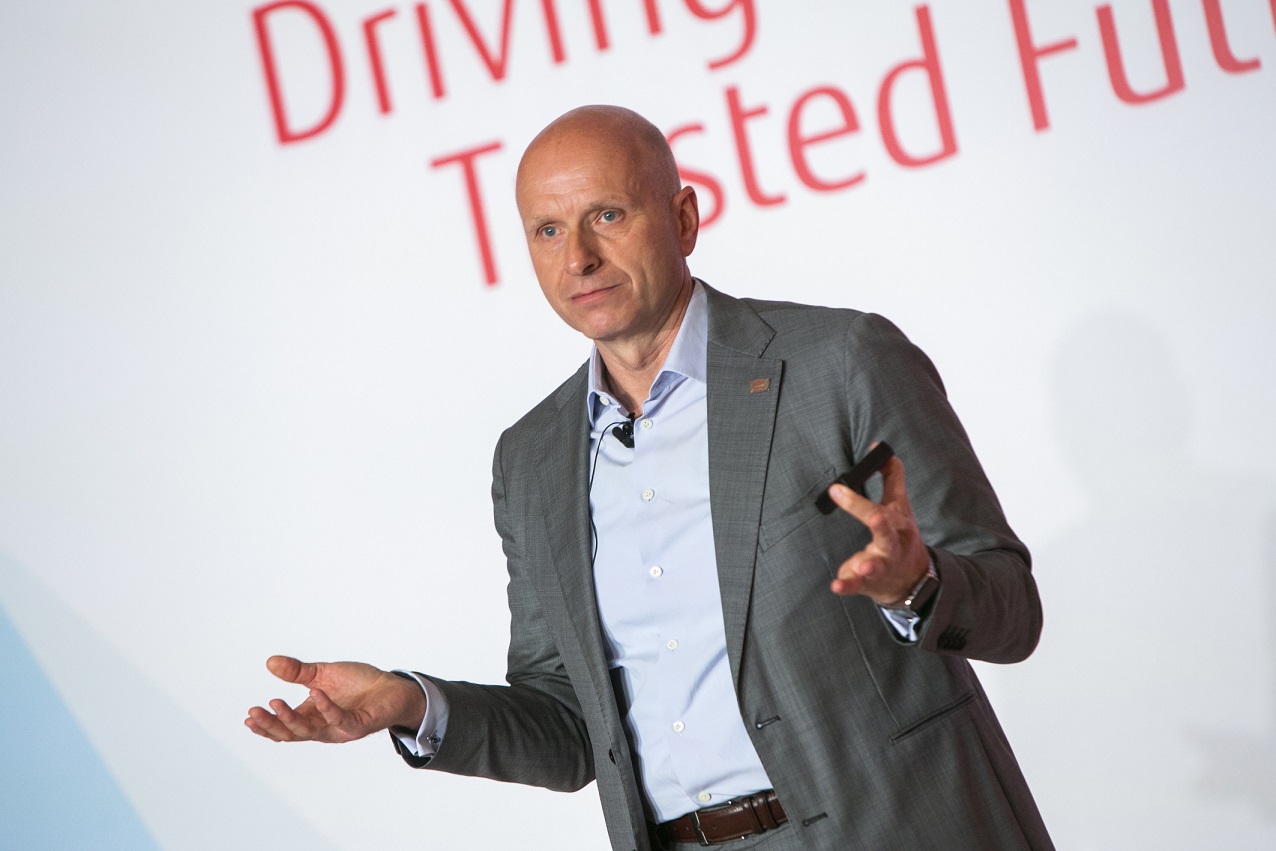
Udo Württz, Fujitsu's Chief Specialist for Data Center Promotion in EMEIA
At present, two-thirds of the artificial intelligence-related market is occupied by projects in the field of deep and machine learning, and almost a third are natural language processing and computer vision. And only 2% are projects related to machine argumentation.
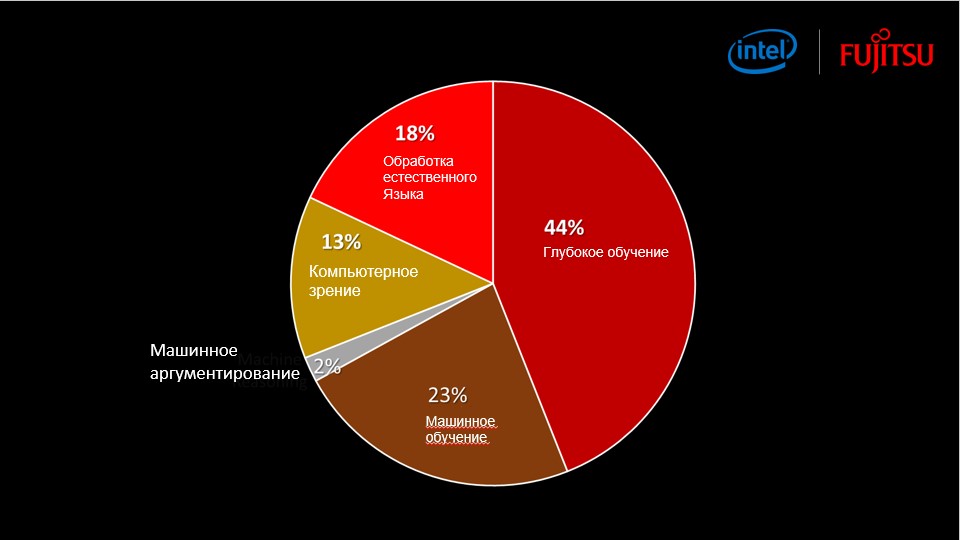
Such numbers are understandable. As Joseph Reger mentioned, we only got to a narrow AI capable of performing only specific tasks. At the same time, the process of training these tasks can require huge resources. Many companies simply cannot afford to pay such a price just for training and testing AI models. Therefore, there is an extremely high demand on the market for developments capable of speeding up and cheapening the learning process.
Feeling the general mood of customers and noticing a request for solutions that would make the deep learning process less expensive, Fujitsu developed and launched the Deep Learning Unit (DLU) chip and the Zinrai Deep Learning System (ZDLS) based on it. When developing DLU, Fujitsu was guided by three main principles: maximum performance, compatibility with existing systems, and scalability.
According to Udo, the company ended up with an alternative to GPU-based training systems, which significantly reduces the time it takes to train and test artificial intelligence models. The latter are capable of showing really high performance, but not for long, when AI needs to be studied for days and weeks. Therefore, it is important to constantly ensure high performance, which DLU copes with.
In systems based on GPU, the cores work autonomously and it is necessary to spend time synchronizing their work; in ZDLS, in the process of the kernel, they constantly “share” their results, saving time.

ZDLS also uses the adaptive numerical format Deep Learning Integer (DL-INT), specially designed for deep learning to increase the speed and accuracy of calculations. DLU uses shorter number representation formats: instead of 32 bits for floating-point numbers (FP32), the 8-bit DLINT8 format is used. And the bulk of the operations are performed just on eight-digit DLINT numbers. Together with special algorithms to minimize errors, the accuracy of such calculations is the same as for FP32, but they are much faster.

But another important point in the presentation of Udo Wurtz was that DLU saves energy. Of course, Udo demonstrated savings calculations for Germany, France and Finland, where electricity is more expensive than in Russia. But even here it was difficult not to notice a reduction in electricity costs by more than 3 times. At the same time, the performance per 1 W of energy consumed by the Zinrai Deep Learning System is 10 times higher than that of alternative solutions.
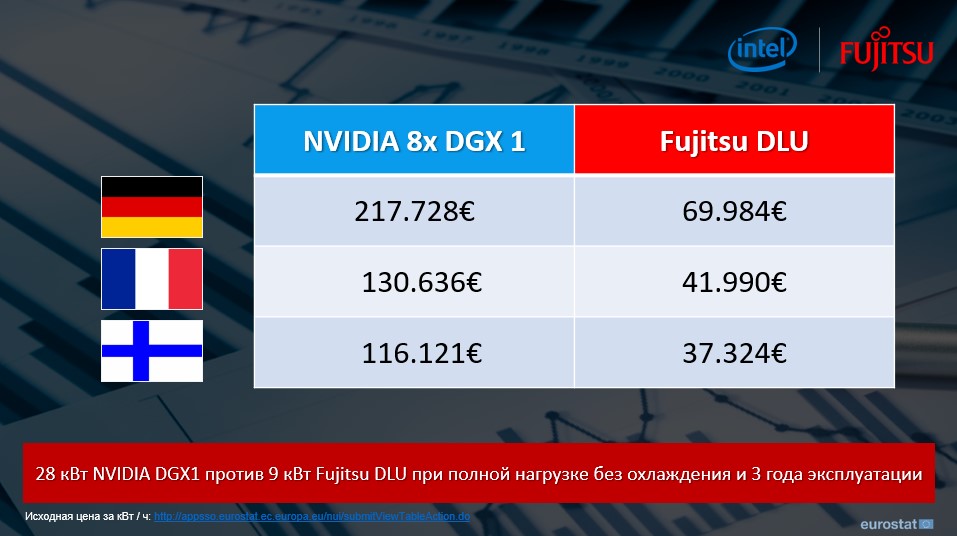
Next came various specific examples of using ZDLS: quality control in the production of Siemens Wind Power wind turbines, recognition of images from surveillance cameras for unmanned vehicles, traffic analysis on the roads, analysis and prediction of problems or breakdowns, etc. An interesting scenario is the use of camera image analysis to identify workplace injuries. The system can analyze a person’s posture and determines, for example, a sitting posture as normal, but if an employee is lying on the floor, then it's time to send a signal to be checked, he may need medical help.


At the end of this year, ZDLS plans to offer around the world not only as part of pilot projects, so that soon in Russia it will be possible to take advantage of DLU.
Udo's presentation was followed by several presentations from partners and customers of Fujitsu, where they shared their experience of working with the company to solve various complex tasks, for example, organizing disaster-proof data storage solutions, using computer vision to analyze traffic and helping solve crimes.
After the plenary part of the conference, rewarding of customers and partners, as well as a short break, three parallel technological sessions began, where the conference participants together with experts examined specific practical steps to solve the problems of their business.
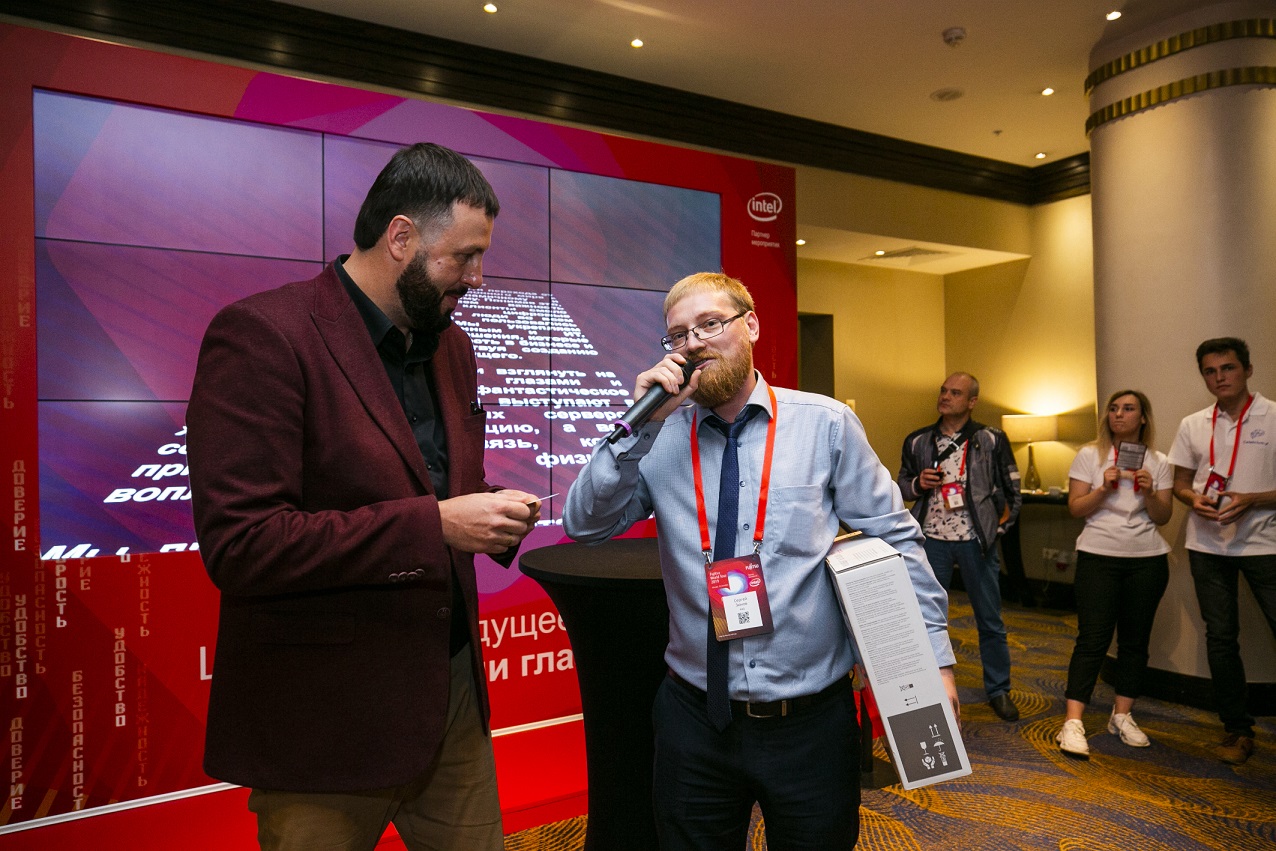

This long, but not boring day ended with a prize draw and traditional communication, or as it is fashionable to talk about networking now, because the Fujitsu World Tour is not about “showing yourself” anymore, but about communication, meeting old friends and new acquaintances. We have not seen many for the first time, but there have been many new faces whom we hope to meet again next year. Come and visit us in the fall of 2020, until you know what the general theme will be in a year, who will perform from the stage, what new products will be shown, but it will be definitely interesting.
Materials from the Fujitsu World Tour 2019 conference can be found here . Photo report here .